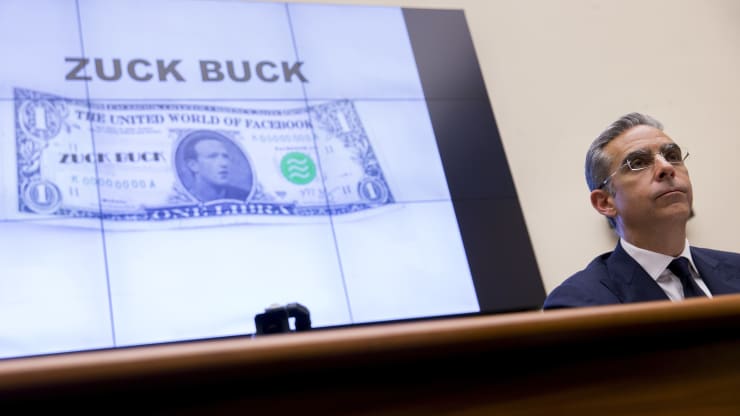In this video we summarize in five minutes the background of cryptocurrencies, talking about its history, creation and evolution to this day, talking about different aspects related to this electronic money. We talk about the impact and consequences, about how the world economy has changed. We analize how the market has changed in the way cryptocurrencies affect the real economy, talking about investors and how they are diversifying their investments, including these cryptocurrencies as a new category of assets. We finally talk about Facebook Libra and how it could revolutionize the market. At the end of this video, we propose an open question to the viewer.
THE BIG SHORT
Everyone knows the impact that the economic crisis of 2008 has had in the world, but not everyone knows that four investors l had hypothesized, implementing «the big short». This scene of the film «The big short» talks about an eccentric manager, Michael Berry, who discovers that the USA Real Estate market was extremely unstable. It is formed by high-risk subprime mortgages. They are mortgages granted to people with financial problems who have often been unable to repay them. These mortgages are granted, however, because the banks apply the guarantee on them «collateral mortgage». If the debtor fails to pay the installments, the bank forecloses the house. It is good for financial institutions: Real Estate acquires value over time and can easily be sold at a higher price.
Michael begins to study the story and realizes that the number of debtors entering insolvency is increasing. This means that the banks will find themselves with thousands of foreclosed houses and with the huge offer, the value of these houses will begin to fall. Moreover, insolvencies increase, so few people will be able to buy them. He decides to bet against the Real Estate market by creating credit default swaps. Michael had offered banks a periodic insurance premium on a harmful event. In fact, the banks were only required to pay a premium if the event had actually occurred and the banks accepted certain solidity of the Real Estate market.
Taken from a true story, this film tells a chapter of contemporary history, from another
more exciting point of view in the dark part of banking systems, doubting everyone.
Lucia Scotti
NEGATIVE INTEREST RATES
In this video we talk about interest rates, their different uses in the economy and the current situation, that is, the negative interest rates scenario. It is a very important topic to deal with, as interest rates have an important impact in the economy, in particular during deflationary periods when people or institutions are inclined to hoard money, rather than spend or lend it.
On the other hand, we also offer a historical trip while talking about negative interest rates in countries such as Japan, the United States or the European countries.
Finally, we conclude with the advantages and disadvantages of negative interest rates.
Gru trying to get a loan
Most of people don’t understand how banks really work, they believe that banks have unlimited money and can lend unlimitedly. However, as resources are limited, banks have to lend the money assuming the minimum risk. The banker’s sentence «there are a lot of new villains out there younger than you» in the video refers to those better customers to lend to, in terms of risk.
Fintech and Neobanks
- What is FinTech?
Financial technology, FinTech for short, describes transformation and evolution of financial services and technology.
The term can refer to start-ups, technology companies or even legacy service providers.
It is increasingly difficult to know where technology ends and where financial services begin.
- Who’s doing this and what does a typical FinTech company look like?
When people think of FinTech, they often focus on startups, breaking into areas that banks and other legacy financial institutions have dominated. But we must think of all participants in a larger FinTech ecosystem:
- Well-established financial institutions such as Bank of America.
- Big tech companies such as Apple, Google, Facebook, and Twitter.
- Disruptors: fast-moving companies, often startups, focused on a particular innovative technology or process.
- What’s a neobank?
We can define neo-banks as an institution that provides some combination of checking accounts, savings accounts and debit cards via digital channels—primarily mobile—without any physical bank branches.
- How else do neobanks differ from traditional banks?
Financial analysts say neobanks stand out because of these features:
- Low cost structure
- Large ATM networks with no fees.
- No overdraft fees because the checking products are prepaid, reloadable debit cards.
- A simple and engaging mobile experience, unlike banking on a phone with a traditional bank.
- Intuitive budgeting and money-tracking tools.
- Real-time balances.
- What are the disadvantages of a neobank?
- If you need bank branch access, a neobank won’t be a good fit.
- If you’re paid in cash, a neobank isn’t likely your first choice, either. While there are options to deposit cash via Green Dot sites, as mentioned above, sometimes the sites charge a fee.
- Also, if you’re looking for a bank that will grow with you as your needs evolve, a neobank might not be the best choice. That is not to say neobanks themselves aren’t evolving, and this criticism might not be true within a few years.
- When you’re ready to buy a house, your neobank might be in the mortgage business, or when you inherit some money they might a wealth management product. However, they might not.
- What is the future of neobanks?
- Existing neobanks will likely expand into new product lines and look to become chartered banking institutions.
- Traditional banks will look likely for ways to tap this market with new sub-brands like Wells Fargo’s Greenhouse or Chase’s Finn.
- And fintech players in other lines will look to get into the deposit business.
The other variable is the global landscape. Neobanks are known as “challenger banks” in Europe, and several of them have their eyes set on the U.S. market but are looking for more clarity on how they might navigate the American banking system, which is fairly complex given the national chartering structure, the state chartering structure and the laws surrounding delivering services without branches.
As it stands now, many of those hurdles are enough to keep many on the other side of the Atlantic.
Resources:
https://relayto.com/pwc-financial/questions-and-answers-fintech-b0zaegbp
https://www.bankrate.com/banking/5-questions-to-ask-before-trying-a-neobank/
PSD2 Directive on Payment Methods

PSD2 is the European Directive that regulates payment services (for example transfers, direct debits or card payments) made in Europe, with the proposal to promote transparency, competition, and innovation of payment services in the financial sector . It also allows third companies to intervene in payments. This is what is known as «open banking».
The PSD2 regulates and harmonizes two types of services that already existed when the first PSD was adopted in 2007: payment initiation services (PIS) and account information services (AIS).
The AIS consists of collecting and specifying the information of the different bank accounts of a client in one place, while the PIS facilitate the use of online banking to make payments online.
Exposition of the mural with more detailed information:
Links:
https://www.triodos.es/es/que-es-psd2
https://www.bbva.com/es/lo-saber-la-psd2/
https://www.bbva.es/finanzas-vistazo/ef/banca-digital/psd2.html
Banking and Big Data

Big Data is a set of high volume, high speed and / or high variety data that requires new forms of processing to improve decision making processes, research and process optimization. Its appearance in the 2000’s is explained by the fact that this set of data was difficult or impossible to process using traditional methods. Doug Laney (industry analyst) articulated the definition of Big Data as de three V’s:
- Volume: It refers to the extreme volumen of data that organizations must process.
- Velocity: There is a growing need to deal with these data torrents in near real time.
- Variety: Data comes in a wide variety of types. From structured (for instance,the numeric one) to unestructured (such as videos and text documents).
The importance of Big Data lies in the fact that with it you can take data from any source and analyse it to find answers that enable costs and time reduction, optimization and smart decision making.
About the relationship between Big Data and banks, it is important to know that the banking sector is one of the business domains that makes the highest investment in Big Data. Thanks to this relationship banks gets the data and from all the information contain, take out the useful and profitable information. In summary, Big Data has helped the banks in the following aspects:
- Personalized customer experience, where the bank uses Big Data to know their users and find new ways to cater to them.
- User segmentation and product targeting: by using Big Data, you can better understand your customer’s needs and also to pinpoint problems in your product targeting.
- Business process optimization and automatization.
- Improved cybersecurity and risk management by identifying fraud or preventing terrorist activities.
- Better employee performance and management.
Links:
The Guarantee Fund for Deposits of Credit Institutions
This video pretends to clarify what the Guarantee Fund for Deposits of Credit Institutions is. We structured it in four main parts: the first one consists in a short introduction where we explain the most important aspects of this spanish entity. In the second one, we talk about how it works in other countries: Central Africa countries, Korea (both North and South Korea) and the United States. We left the European Deposit Insurance Scheme for the third part, where we introduce this plan and how it will help banks in the euro area.
We decided to end up this video with some conclusions, where we show our concern about the DGF, the current situation of Spain’s economy and its effects in the market, since we are facing an economic slowdown.
Facebook says Libra could use a series of cryptocurrencies pegged to different currencies

A “Zuck Buck” is displayed on a monitor as David Marcus, the executive leading Facebook’s blockchain initiative, is questioned by U.S. lawmakers in Washington, D.C., on July 17, 2019.
Date: October, 21st 2019
Media: CNBC
What happened?
Facebook has suggested its Libra project could use multiple cryptocurrencies backed by different existing currencies like the dollar, rather than having one single digital token tied to a basket of currencies. Instead of having a synthetic unit they are using a series of stablecoins, a dollar stablecoin, a euro stablecoin, a sterling pound stablecoin, etc. These currencies are focused on reducing the volatility observed in virtual currencies such as bitcoin and others. With this project they want to create a more efficient cross-border payment system.
Whom and where it affects?
It would affect the whole world, specially most developed countries where most of people have access to internet, it will also affect the international banking and financial system. Although People still aren’t very familiar with this cryptocurrencies, they are gaining popularity and it’s a reality they will become more important with time.
What sort of public or private institutions are involved?
The Association libra, the hand that guides the nascent cryptocurrency, is composed of partner companies. The Libra Association will be an independent non-profit organization based in Geneva, Switzerland. Its aim is to coordinate and provide a framework for governance on the Libra network and to reserve and guide grants of social impact in support of financial inclusion. The association is constituted from the net of nodes validators that manage the blockchain Libra. Its members will consist of geographically distributed and diversified enterprises, non-profit and multilateral organisations and academic institutions.
Why is it important for Banking and Finance?
It is important because basically this new system will be backed up by different existing currencies so only for that reason it will affect traditional banking and change it in the way people percieve money, this change has already began with other cryptocurrencies that exist already, so every time people fear less to this new concept of money and for sure its going to be the future of our finances.
What do you think will be the consequences in the foreseeable future?
The advantages of this type of money is that is an excellent alternative for many people who have to send money. Apart from being a currency with a limitation in its issuance, they allow that before the increase in its demand its price has risen and therefore becoming an excellent investment. It is also a technology that allows you to create automatic rules to money. All these great advantages allow us to predict that its use will continue to grow.
We can see many transactions that are made, new very powerful players that are entering, new projects that are emerging, after all, it is our day to day, and all these are very strong indicators that we are on the right track.
Today may not be the best system in all situations, but it is certainly an unstoppable evolution. The spread of bitcoins in the world as a global currency is already a reality, the development of solutions that solve some gaps is already underway, the revolution that the blockchain has brought and is also bringing to other sectors, beyond the systems of payment, is constantly increasing.
All the largest companies have already realized the value of that technology and are focusing on solutions to implement them in their businesses.
Key words:
Cryptocurencye, Blokchain, Stablecoins, Bitcoin and Volatility.
Long-term negative rates have ‘adverse consequences’ we don’t fully understand, says Jamie Dimon

Above, Jamie Dimon
(Diane Bondareff / Invision for JP Morgan Chase)
Link: Long-term negative rates have ‘adverse consequences’ we don’t fully understand, says Jamie Dimon
Date: 21st October 2019
Media: CNBC
What happened?
The article talks about various topics, which, of course, are all intertwined. First and foremost we have to mention that the rate at which the economy is growing is slowing down, this is caused by various geopolitical factors, such as the Brexit deal and the U.S.-China trade war. This, in turn, is the main reason why the interest rates are at an all-time low, reaching, in some places, numbers below zero.
Whom and where does it affect?
As one might imagine, the decrease in interest rates has an effect on every participant in our global economy. For example, when interest rates are low, people tend to spend more because investing in financial products generates next to no returns, they also tend to take out more loans to invest in different business venues since loans become «cheaper». Obviously those living in countries where the rates of interest are close to or below zero will be affected the most.
What sort of public or private institutions are involved?
The following public institutions:
- National Central Banks (NCB)
- European Central Bank (ECB)
- International Monetary Fund (IMF)
The following private institutions:
- Private banks, such as J.P. Morgan Chase
Why is it important for Banking and Finance?
Negative interest rates change the normal way of how banking is done. Having negative interest rates, essentially means that deposits will incur a charge instead of receiving interest. i.e. you will have to pay to have your money in a bank instead of being paid for having said deposit.
What will the consequences be in the foreseeable future?
The consequences will depend on the future development of the interest rates and decision-making of central banks. There are two possible outcomes:
- The continuous drop in interest rates below zero. This outcome would cause a fall in the consumption of financial products, even a cash withdrawal if banks started to charge for having a bank deposit. On the other side, people would be even more tempted to take out loans and invest in businesses.
- The rise in interest rates, resurfacing above zero. This would, probably, end in a massive slowdown of the economy, or even, a recession.
Key words:
ECB, Bank of Japan, negative interest rates, recession, slowdown, European Union, United States, Jamie Dimon
